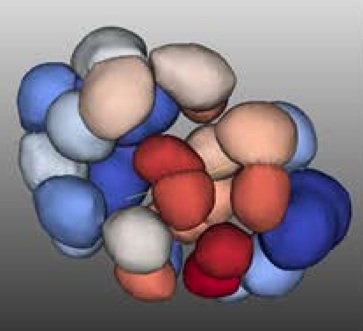HiPACC Data Science Press Room. From: LBNL
The Data Science Press Room highlights computational and data science news in all fields *outside of astronomy* in the UC campuses and DOE laboratories comprising the UC-HiPACC consortium. The wording of the short summaries on this page is based on wording in the individual releases or on the summaries on the press release page of the original source. Images are also from the original sources except as stated. Press releases below appear in reverse chronological order (most recent first).
November 3, 2014 — Berkeley Lab scientists ID new driver behind Arctic warming

This simulation, from the Community Earth System Model, shows decadally averaged radiative surface temperature changes during the 2030s after far-infrared surface emissivity properties are taken into account. The right color bar depicts temperature change in Kelvin. Credit: LBNL
LBNL 11/3/2014—Research led by Lawrence Berkeley National Laboratory studying the far infrared have identified a mechanism that could turn out to be a big contributor to warming in the Arctic region and melting sea ice. Far infrared (15 to 100 micrometers) emits about half the energy radiated by the Earth’s surface, balancing out incoming solar energy. Despite its importance in the planet’s energy budget, it’s difficult to measure a surface’s effectiveness in emitting far-infrared energy. In addition, its influence on the planet’s climate is not well represented in climate models. The models assume that all surfaces are 100 percent efficient in emitting far-infrared energy. However, the research found that non-frozen surfaces are poor emitters compared to frozen surfaces. Specifically, open oceans are much less efficient than sea ice when it comes to emitting in the far-infrared region of the spectrum. That discrepancy has a much bigger impact on the polar climate than today’s models indicate. This means that the Arctic Ocean traps much of the energy in far-infrared radiation, a previously unknown phenomenon that is likely contributing to the warming of the polar climate. Simulations revealed something similar also may happen in arid regions, such as the Tibetan plateau. Their research appears in the
Proceedings of the National Academy of Sciences.
View LBNL Data Science Press Release
October 23, 2014 — Water and gold: A promising mix for future batteries
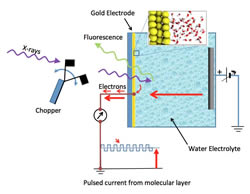
Schematic of the gold-water electrochemical cell under testing conditions
LBNL/NERSC 10/23/2014—For the first time, researchers at the Lawrence Berkeley National Laboratory (LBNL) have observed the molecular structure of liquid water at a gold surface under different charging conditions as in a battery. These experiments result in absorption vs. x-ray energy curves (spectra) that reflect how water molecules within nanometers of the gold surface absorb the x-rays. To translate that information into molecular structure, the team also developed computational techniques. Supercomputer facilities at LBNL’s National Energy Research Scientific Computing Center (NERSC), conducted large molecular dynamics simulations of the gold-water interface and then predicted the x-ray absorption spectra of representative structures from those simulations. It turns out that the inert gold surface can induce significant numbers of water molecules not to hydrogen-bond to each other but to bond to the gold instead. The findings were published October 23 in
Science.
LBNL release
NERSC release
October 20, 2014 — DOE’s high-speed network to boost Big Data transfers by extending 100G connectivity across Atlantic

LBNL 10/20/2014— The Department of Energy’s (DOE’s) Energy Sciences Network, or ESnet, is deploying four new high-speed transatlantic links, using network capacity leased from the owners of four undersea cable, giving researchers at America’s national laboratories and universities ultra-fast access to scientific data from the Large Hadron Collider (LHC) and other research sites in Europe. ESnet’s transatlantic extension will deliver a total capacity of 340 gigabits-per-second (Gbps), and serve dozens of scientific collaborations. To maximize the resiliency of the new infrastructure, ESnet equipment in Europe will be interconnected by dedicated 100 Gbps links from the pan-European networking organization GÉANT. Funded by the DOE’s Office of Science and managed by Lawrence Berkeley National Laboratory, ESnet provides advanced networking capabilities and tools to support U.S. national laboratories, experimental facilities and supercomputing centers. Among the first beneficiaries will be particle physicists, but significant network traffic across the Atlantic is also expected from other such data-intensive fields as astrophysics, materials science, genomics, and climate science.
View LBNL Data Science Press Release
October 16, 2014 — Dispelling a misconception about Mg-ion batteries
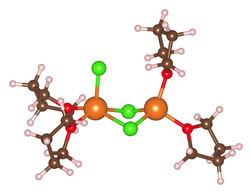
Using first-principles molecular dynamics simulations, LBNL researchers found that Mg-ions (orange) are coordinated by only four or five nearest neighbors in the dichloro-complex electrolyte rather than six as was widely believed.
LBNL/NERSC 10/16/2014— Lithium (Li)-ion batteries power our laptops, tablets, cell phones, and a host of small gadgets and devices. Future automotive applications, however, will need rechargeable batteries with greater energy density, lower cost, and greater safety. Hence the big push in the battery industry to develop an alternative to the Li-ion technology. One promising alternative would be a battery based on a multivalent ion, such as magnesium (Mg). Whereas a Li-ion with a charge of +1 provides a single electron for an electrical current, a Mg-ion has a charge of +2. In principle, that means the same density of Mg-ions can provide twice the electrical current of Li-ions. Mg-ion batteries would also be safer and less expensive than Li-ion batteries. However, the additional charge on a multivalent ion creates other problems: they move more slowly through a circuit. It has long been believed they become surrounded in the battery’s electrolyte by other oppositely charged ions and solvent molecules, slowing their motion and hampering the development of Mg-ion batteries. New findings from a series of computer simulations, however, indicate the problem may be less severe than feared. Results have been published in
Journal of the American Chemical Society.
Read full NERSC press release.
View LBNL Data Science Press Release
September 10, 2014 — Advanced Light Source sets microscopy record
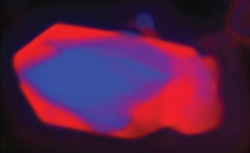
Ptychographic image using soft X-rays of lithium iron phosphate nanocrystal after partial dilithiation. The delithiated region is shown in red.
LBNL 9/10/2014—A record-setting X-ray microscopy experiment may have ushered in a new era for nanoscale imaging. Working at the U.S. Department of Energy (DOE)’s Lawrence Berkeley National Laboratory (LBNL), a collaboration of researchers used low energy or “soft” X-rays to image structures only five nanometers in size. This resolution, obtained at LBNL’s Advanced Light Source (ALS) is the highest ever achieved with X-ray microscopy. Using ptychography, a coherent diffractive imaging technique based on high-performance scanning transmission X-ray microscopy (STXM), the collaboration was able to map the chemical composition of lithium iron phosphate nanocrystals after partial dilithiation. The results yielded important new insights into a material of high interest for electrochemical energy storage. Key to the success of Shapiro and his collaborators were the use of soft X-rays which have wavelengths ranging between 1 to 10 nanometers, and a special algorithm that eliminated the effect of all incoherent background signals. The findings were published in the journal
Nature Photonics.
View LBNL Data Science Press Release
September 5, 2014 — New catalyst converts CO₂ to fuel
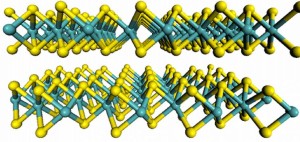
Structure of 2D molybdenum disulfide. Molybdenum atoms are shown in teal, sulfur atoms in yellow. Credit: Wang et al, Massachusetts Institute of Technology
LBNL/NERSC 9/5/2014—Scientists from the University of Illinois at Chicago have synthesized a catalyst that improves their system for converting waste carbon dioxide (CO₂) into syngas, a precursor of gasoline and other energy-rich products, bringing the process closer to commercial viability. The unique two-step catalytic process uses molybdenum disulfide and an ionic liquid to transfer electrons to CO₂ in a chemical reaction. The new catalyst improves efficiency and lowers cost by replacing expensive metals like gold or silver in the reduction reaction, directly reducing CO₂ to syngas (a mixture of carbon monoxide plus hydrogen) without the need for a secondary, expensive gasification process. Supercomputing resources at the U.S. Department of Energy’s National Energy Research Scientific Computing Center (NERSC) helped the research team confirm their experimental findings.
View LBNL,NERSC Data Science Press Release
August 27, 2014 — Encyclopedia of how genomes function gets much bigger

Berkeley Lab scientists contributed to an NHGRI effort that provides the most detailed comparison yet of how the genomes of the fruit fly, roundworm, and human function. Credit: Darryl Leja, NHGRI
LBNL 8/27/2014—A big step in understanding the mysteries of the human genome was taken in three analyses that provide the most detailed comparison yet of how the genomes of the fruit fly, roundworm, and human function. The research, appearing August 28 in the journal Nature, compares how the information encoded in the three species’ genomes is “read out,” and how their DNA and proteins are organized into chromosomes. The results add billions of entries to a publicly available archive of functional genomic data. Scientists can use this resource to discover common features that apply to all organisms. These fundamental principles will likely offer insights into how the information in the human genome regulates development, and how it is responsible for diseases.
View LBNL Data Science Press Release
August 26, 2014 — Photon speedway puts big data In the fast lane
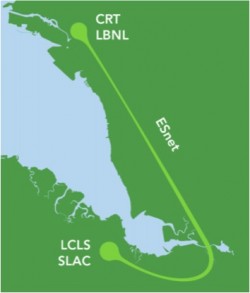
Scientists envision ESnet serving as a “photon science speedway” connecting Stanford’s advanced light sources with computing resources at Berkeley Lab.
LBNL/NERSC 8/26/2014—A series of experiments conducted by Lawrence Berkeley National Laboratory (LBNL) and SLAC National Accelerator Laboratory (SLAC) researchers and collaborators is shedding new light on photosynthesis, and demonstrating how light sources and supercomputing facilities can be linked via a “photon science speedway” called ESnet to better address emerging challenges in massive data analysis. Last year, LBNL and SLAC researchers led a protein crystallography experiment at SLAC’s Linac Coherent Light Source to look at the different photoexcited states of an assembly of large protein molecules that play a crucial role in photosynthesis. Subsequent analysis of the data on supercomputers at the Department of Energy’s (DOE’s) National Energy Research Scientific Computing Center (NERSC) helped explain how nature splits a water molecule during photosynthesis, a finding that could advance the development of artificial photosynthesis for clean, green and renewable energy.
View LBNL,NERSC Data Science Press Release
August 25, 2014 — New project is the ACME of addressing climate change
LBNL 8/25/2014—Eight Department of Energy national laboratories, including Lawrence Berkeley National Laboratory (LBNL), are combining forces with the National Center for Atmospheric Research, four academic institutions and one private-sector company in the new effort. Other participating national laboratories include Argonne, Brookhaven, Lawrence Livermore, Los Alamos, Oak Ridge, Pacific Northwest and Sandia. The project, called Accelerated Climate Modeling for Energy (ACME), is designed to accelerate the development and application of fully coupled, state-of-the-science Earth system models for scientific and energy applications. Over a planned 10-year span, the project aims to conduct simulations and modeling on the most sophisticated HPC machines as they become available, i.e., 100-plus petaflop machines and eventually exascale supercomputers.
View LBNL Data Science Press Release
August 18, 2014 — SPOT Suite transforms beamline science
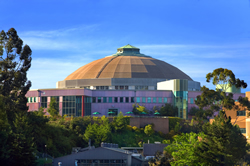
Advanced Light Source (ALS) at Berkeley Lab. Credit: Roy Kaltschmidt
LBNL/NERSC 8/18/2014—For decades, synchrotron light sources such as the DOE’s Advanced Light Source (ALS) at LBNL have been operating on a manual grab-and-go data management model—users travel thousands of miles to run experiments at the football-field-size facilities, download raw data to an external hard drive, then process and analyze the data on their personal computers, often days later. But the deluge of data brought on by faster detectors and brighter light sources is quickly making this practice implausible. Fortunately, ALS X-ray scientists, facility users, computer and computational scientists from the Computational Research Division (CRD) and National Energy Research Scientific Computing Center (NERSC) of Lawrence Berkeley National Laboratory (LBNL) recognized this developing situation years ago and teamed up to create new tools for reducing, managing, analyzing and visualizing beamline data. The result of this collaboration is SPOT Suite, which is already transforming the way scientists run their experiments at the ALS. The goal is for beamline scientists to be able to access computational resources without having to become computer experts.
View LBNL,NERSC Data Science Press Release
July 11, 2014 — Berkeley Lab wins three 2014 R&D 100 Awards
LBNL 7/11/2014—The U.S. Department of Energy (DOE)’s Lawrence Berkeley National Laboratory (LBNL) has won three 2014 R&D 100 awards. This year’s winners include a bioinformatics platform for screening 3-D cell culture models. Called BioSig3D, it is a computational platform for high-content screening of three-dimensional cell culture models that are imaged in full 3-D volume. It is primarily used for the study of aberrant organization that is typically caused by cancer, as well as the evaluation and quantification of the effects of exposure to radiation and environmental toxins. Presented by R&D Magazine, the R&D 100 Awards recognize the year’s top 100 technology products from industry, academia, and government-sponsored research, ranging from chemistry to materials to biomedical breakthroughs.
View LBNL Data Science Press Release
June 30, 2014 — Up in flames: Evidence confirms combustion theory
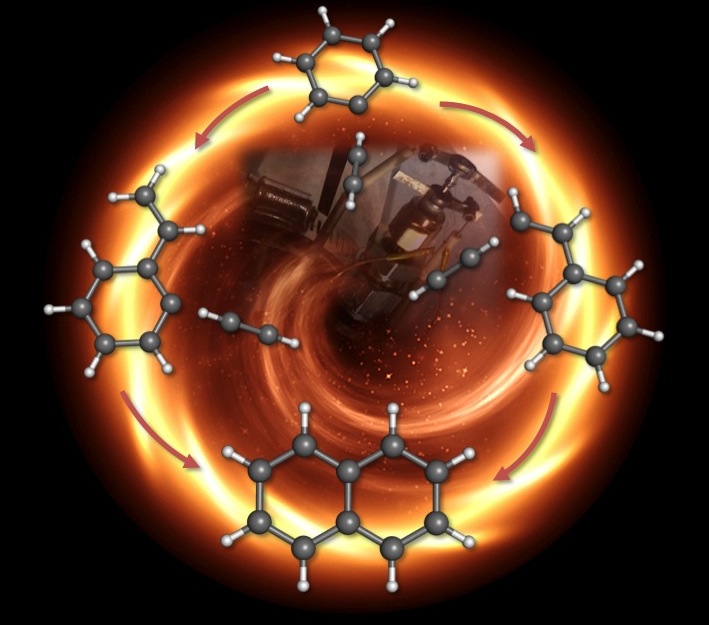
Graphical representation of the chemistry in the early stages of soot formation. The mechanism to the right was demonstrated by experiment, while the one on the left was not. Credit: Dorian Parker, University of Hawaii
LBNL 6/30/2014—Researchers at the Department of Energy’s Lawrence Berkeley National Lab (LBNL) and the University of Hawaii have uncovered the first step in the process that transforms gas-phase molecules into solid particles like soot and other carbon-based compounds. For more than 30 years, scientists have developed computational models of combustion to explain how gas molecules form soot, but now Musahid Ahmed, scientist in LBNL’s Chemical Sciences Division, and his colleagues have data to confirm one long-standing theory. The finding could help combustion chemists make more-efficient, less-polluting fuels, and help materials scientists fine-tune their carbon nanotubes and graphene sheets for faster, smaller electronics. In addition, the results could have implications for the burgeoning field of astrochemistry, potentially establishing the chemical process for how gaseous outflows from stars turn into carbon-based matter in space.
View LBNL Data Science Press Release
June 30, 2014 — ‘Thirsty’ metals key to longer battery lifetimes
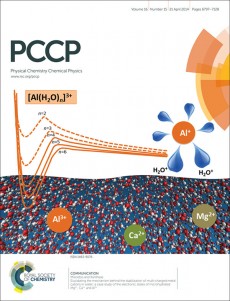
LBNL/NERSC 6/30/2014—Today’s batteries simply do not hold enough charge. Replacing lithium with other metals with multiple charges could greatly increase battery capacity. But first researchers need to understand how to keep multiply-charged ions—ions that have gained or lost more than one electron—stable. Research has shown that when a multiply-charged aluminum or magnesium cation—a positively charged ion—encounters a single water molecule, the result can be explosive. The metal ion rips an electron from the water molecule, causing a molecular-level explosion, triggered by the Coulombic repulsion of the two positive charges on each fragment. But multiply-charged metal ions exist in water in countless ways, such as the calcium ions in a chocolate milkshake. Now, using supercomputers at the National Energy Research Scientific Computing Center (NERSC), a team of Pacific Northwest National Laboratory (PNNL) researchers determined the paths that lead to either the hydrolysis of water or the creation of stable metal ion clusters peaceably surrounded by water.
View LBNL,NERSC Data Science Press Release
June 7, 2014 — Farming: A climate change culprit
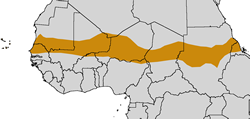
The Sahel region is a narrow swath of semi-arid land that spans the African continent, from the Atlantic Ocean in the west to the Red Sea in the east. The low annual precipitation indicates the region is strongly reliant on the monsoon season for water supply.
LBNL/NERSC 6/7/14—Increased agricultural activity is a rain taker, not a rain maker, according to computer simulations of African monsoon precipitation run by researchers from Pacific Northwest National Laboratory, UC Los Angeles and the University of Texas. Using supercomputers at the Department of Energy’s National Energy Research Scientific Computing Center (NERSC) and Oak Ridge Leadership Computing Facility, the research team fed observed land-use change data into a climate model and found the expansion of agriculture in the African Sahel region decreases summer rainfall through its impact on monsoon rains. The simulated decrease in summer rainfall reaches 10 percent over the Sahel, a region that is already stressed by water needs for human and ecological use. The study findings, which offer new insights into how land-use change may affect regional rainfall, were published in Climate Dynamics.
View LBNL, NERSC Data Science Press Release
May 6, 2014 — Berkeley Lab climate scientist: More extreme heat and drought in coming decades
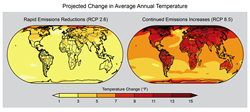
The best case (left) and worst case (right) scenarios considered in the National Climate Assessment both show temperature increases by the end of the century.
LBNL 5/6/14—By the end of this century, climate change will result in more frequent and more extreme heat, more drought, and fewer extremes in cold weather in the United States. Average high temperatures could climb as much as 10 or more degrees Fahrenheit in some parts of the country. These are some of the projections made by Lawrence Berkeley National Laboratory (LBNL) climate scientist Michael Wehner and his co-authors on the National Climate Assessment (NCA). “We have an even more thorough understanding of the human changes to the climate enabled in part by better computer models and their more complete representation of the climate system,” Wehner said.
View LBNL Data Science Press Release
May 1, 2014 — Edgy look at 2D molybdenum disulfide
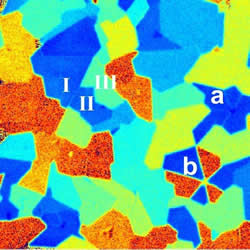
A new imaging technique allows rapid and all-optical determination of the crystal orientations of 2D semiconductor membranes at a large scale, providing the knowledge needed to use these materials in nanoelectronic devices.
LBNL—The drive to develop ultrasmall and ultrafast electronic devices using a single atomic layer of semiconductors has received a significant boost. Researchers with the U.S. Department of Energy (DOE)’s Lawrence Berkeley National Laboratory (LBNL) have recorded the first observations of a strong nonlinear optical resonance along the edges of a single layer of molybdenum disulfide. The existence of these edge states is key to the use of molybdenum disulfide in nanoelectronics, as well as a catalyst for the hydrogen evolution reaction in fuel cells, desulfurization and other chemical reactions.
View LBNL Data Science Press Release
April 29, 2014 — Atomic switcheroo explains origins of thin-film solar cell mystery
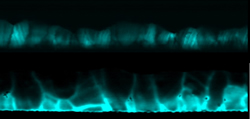
Cross-sectional electron beam-induced current maps show the difference in cadmium telluride solar cells before (pictured above) and after (below) cadmium chloride treatment. The increased brightness after treatment indicates higher current collection at the grain boundaries.
NERSC/LBNL 4/29/14 — Scientists have known since the 1980s that treating cadmium-telluride (CdTe) solar cell materials with cadmium-chloride improves efficiency, but the underlying physics has remained a mystery until now. Combining electron microscopy with computer simulations run at the Department of Energy’s National Energy Research Scientific Computing Center (NERSC), researchers have put this decades-long debate to rest. Beyond providing a long-awaited explanation, this finding could lead to a less-expensive, more easily fabricated, thin-film alternative to silicon-based photovoltaic solar cells.
View LBNL,NERSC Data Science Press Release
April 23, 2014 — Calming plasma’s stormy seas
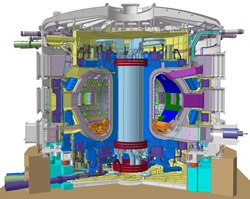
Interior view of the ITER tokamak reactor under construction in Cadarache, France. In a tokamak, turbulence caused by microinstabilities in the plasma can significantly impact energy confinement. Image: ITER
NERSC/LBNL 4/23/14 — For decades, controlled nuclear fusion has held the promise of a safe, clean, sustainable energy source that could help wean the world from fossil fuels. But the challenges of harnessing the power of the Sun in an Earth-based nuclear fusion reactor have been many. One key technical issue that has long puzzled physicists commonly occurs in fusion reactions: turbulence inside a reactor can increase the rate of heat loss from the hot plasma, significantly impacting the resulting energy output. So researchers have been working to pinpoint both what causes plasma turbulence and how to control or even eliminate it to boost a fusion reactor’s energy output. Now simulations run at the National Energy Research Scientific Computing Center (NERSC) have shed light on a central piece of the puzzle: the relationship between fast ion particles in the plasma and plasma microturbulence.
View LBNL,NERSC Data Science Press Release
March 27, 2014 — Human-induced climate change reduces chance of flooding in Okavango Delta

This image is a compilation of three images from Envisat’s radar and shows where southwestern Africa’s Okavango River, which originates in Angola, empties into the inland Okavango Delta in northern Botswana. The (Image credit: European Space Agency)
LBNL/NERSC 3/27/14 — Researchers at the Lawrence Berkeley National Laboratory (LBNL), the University of Cape Town, and the United Nations Development Programme have analyzed how human-induced climate change has affected recent flooding in the Okavango River, an ecologically and geographically unique river basin in southern Africa. After seasonal rains fall in southern Angola, floodwaters flow slowly down the Okavango River into semi-arid northwestern Botswana, where the river spreads, floods, and eventually evaporates within the inland Okavango Delta. The annual floods of 2009, 2010, and 2011 all reached extents last seen decades ago. Were these unusually high floods related to human-induced climate change? In this study, a first of its kind carried out on the African continent, researchers addressed this question by producing a unique set of simulations generated by two computer models of the climate system.
View LBNL,NERSC Data Science Press Release









